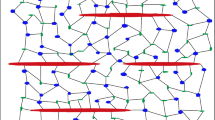Abstract
In this work we interpret the data showing unusually strong velocity dispersion of P-waves (up to 30%) and attenuation in a relatively narrow frequency range. The cross-hole and VSP data were measured in a reservoir, which is in the porous zone of the Silurian Kankakee Limestone Formation formed by vertical fractures within a porous matrix saturated by oil, and gas patches. Such a medium exhibits significant attenuation due to wave-induced fluid flow across the interfaces between different types of inclusions (fractures, fluid patches) and background. Other models of intrinsic attenuation (in particular squirt flow models) cannot explain the amount of observed dispersion when using realistic rock properties. In order to interpret data in a satisfactory way we develop a superposition model for fractured porous rocks accounting also for the patchy saturation effect.
Similar content being viewed by others
References
Norris A N. Low frequency dispersion and attenuation in partially saturated rocks. J Acoust Soc Am, 1993, 94: 359–370
Johnson D L. Theory of frequency dependent acoustics in patchy-saturated porous media. J Acoust Soc Am, 2001, 110: 682–694
Müller T M, Gurevich B. One-dimensional random patchy saturation model for velocity and attenuation in porous rocks. Geophysics, 2004, 69: 1166–1172
Pride S R, Berryman J G. Linear dynamics of double-porosity dual-permeability materials, 1 Governing equations and acoustic attenuation. Phys Rev E, 2003, 68: 036603
Brajanovski M, Gurevich B, Schoenberg M. A model for P-wave attenuation and dispersion in a porous medium permeated by aligned fractures. Geophys J Int, 2005, 163: 372–384
Brajanovski M, Müller T M, Gurevich B. Characteristic frequencies of seismic attenuation due to wave-induced fluid flow in fractured porous media. Geophys J Int, 2006, 166: 574–578
Biot M A. Mechanics of deformation and acoustic propagation in porous media. J Appl Phys, 1962, 33: 1482–1498
Bakulin A, Grechka V, Tsvankin I. Estimation of fracture parameters from reflection seismic data — part I: HTI model due to a single fracture set. Geophysics, 2000, 65: 1788–1802
Schoenberg M, Douma J. Elastic-wave propagation in media with parallel fractures and aligned cracks. Geophys Prospect, 1988, 36: 571–590
Parra J O. Poroelastic model to relate seismic wave attenuation and dispersion to permeability anisotropy. Geophysics, 2000, 65: 202–210
Author information
Authors and Affiliations
Corresponding author
Rights and permissions
About this article
Cite this article
Brajanovski, M., Müller, T.M. & Parra, J.O. A model for strong attenuation and dispersion of seismic P-waves in a partially saturated fractured reservoir. Sci. China Phys. Mech. Astron. 53, 1383–1387 (2010). https://doi.org/10.1007/s11433-010-3205-0
Received:
Accepted:
Published:
Issue Date:
DOI: https://doi.org/10.1007/s11433-010-3205-0



